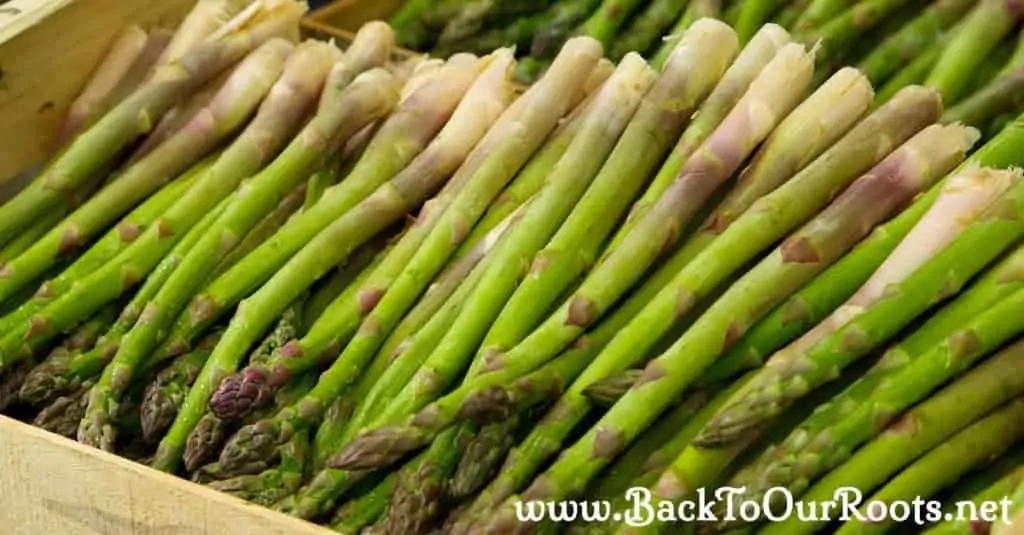
Because I know that means that I’m not too far away from eating that asparagus that is poking up through the soil.
Grilled asparagus, bacon wrapped asparagus, asparagus with Hollandaise sauce, Steamed Asparagus with Balsamic Vinaigrette, pickled asparagus…the list could go on for days.
And while I prefer to eat my asparagus fresh in the spring, it’s nice to have some available for other times of the year.
We typically serve it canned at Thanksgiving and Christmas as a special treat and at other times when cravings hit, so I don’t can huge amounts of asparagus like I do, say, tomatoes for instance. 🙂
So today, I thought I’d teach you how to pressure can asparagus.
For canning asparagus, you need to have about 2-ish pounds per pint jar. You can either buy it all at once from your local farmers’ market, or you can harvest your own as you get it.
Fresh asparagus from your garden will keep for 10-14 days in the fridge if you put it upright in a glass of water. If you get it at the store it will last about 5-7 days.
Because we like the tall spears, I use 1 ½ pint jars so I don’t have to cut so much off of the ends. 1 ½ pints are the same size around as the pint jars, they’re just taller. So they use the same amount poundage wise as the pints.
Here’s What You Need for Canning Asparagus
Fresh asparagus spears
Canning jars (pints, 1 ½ pints, or quarts)
New flat lids (If you are using the Tattler reusable lids
, make sure you follow the directions that came with them.)
Rings
Boiling water
Sea salt (optional)
Pressure Canner
To prepare the asparagus, wash them in a sink of cold water by swishing them back and forth.
Now, bend the spears near the bottom until they snap in two. This separates the “woody” part of the stem from the tender part. Don’t throw those ends out, though. Toss them in the freezer for later.
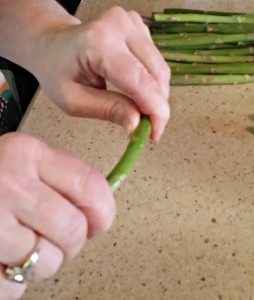
hold the ends and bend
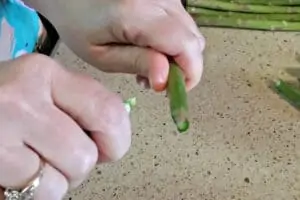
it’s a snap!
You need to measure the height of the jars you will be using. You need a 1 inch headspace, so your spears need to be an inch shorter than the jars.
So put the spears on a cutting board and measure them. Cut the stem off so they are the correct length.
You can add those pieces to the ends you snapped off in the step above. Use them later to make Creamy Asparagus Soup.
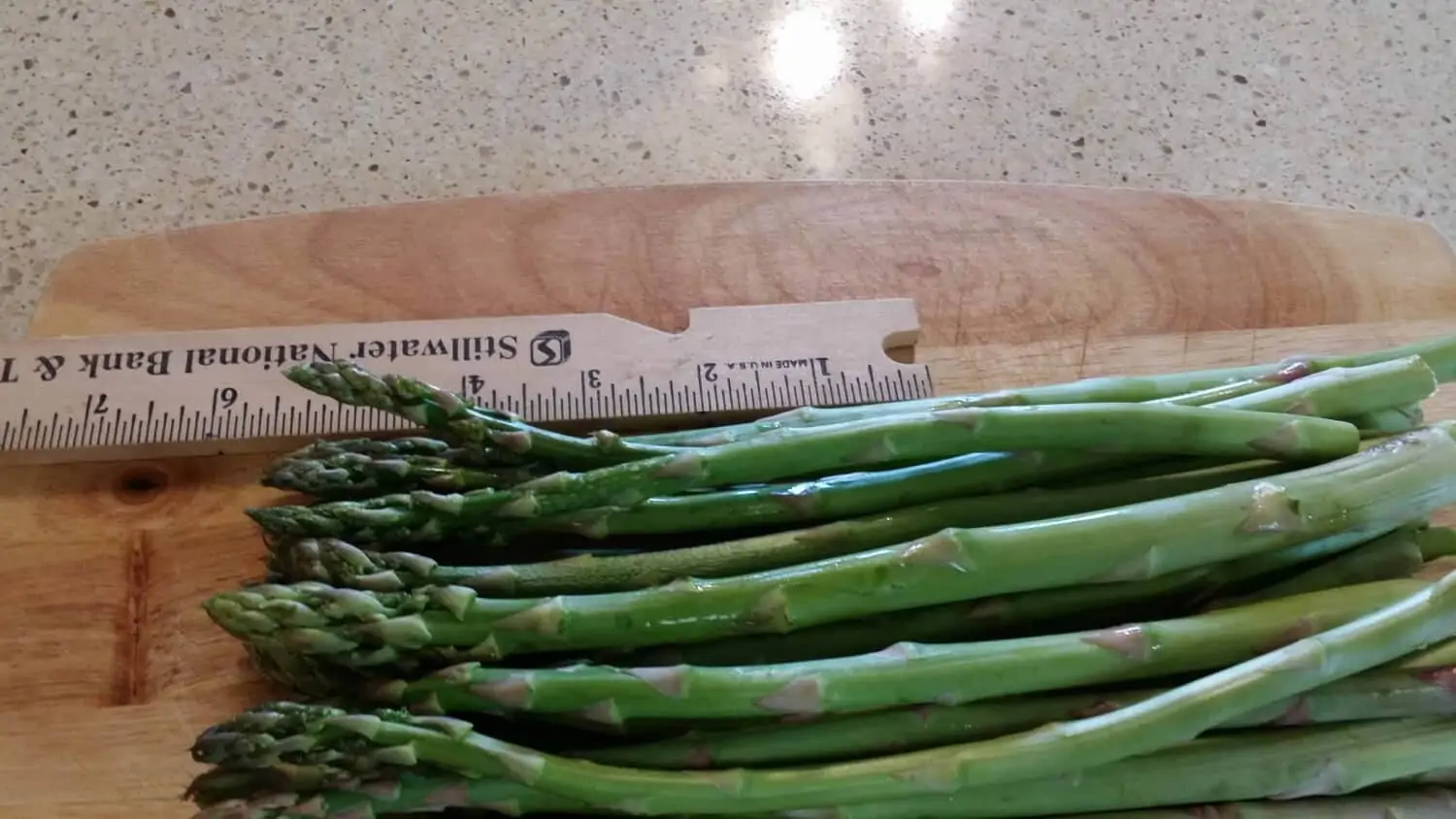
measure twice, cut once
You can raw pack or hot pack your asparagus spears. I prefer the raw pack method for canning asparagus.
Here’s how you raw pack asparagus
Before you begin, make sure your jars are clean and hot, and your lids are prepared according to the manufacturer’s directions.
Pack the spears into the clean, hot jars as tightly as you can. The spears will shrink up dramatically, so really pack ‘em in there.
If you are canning asparagus pieces pack them as tightly as you can leaving 1 inch of headspace.
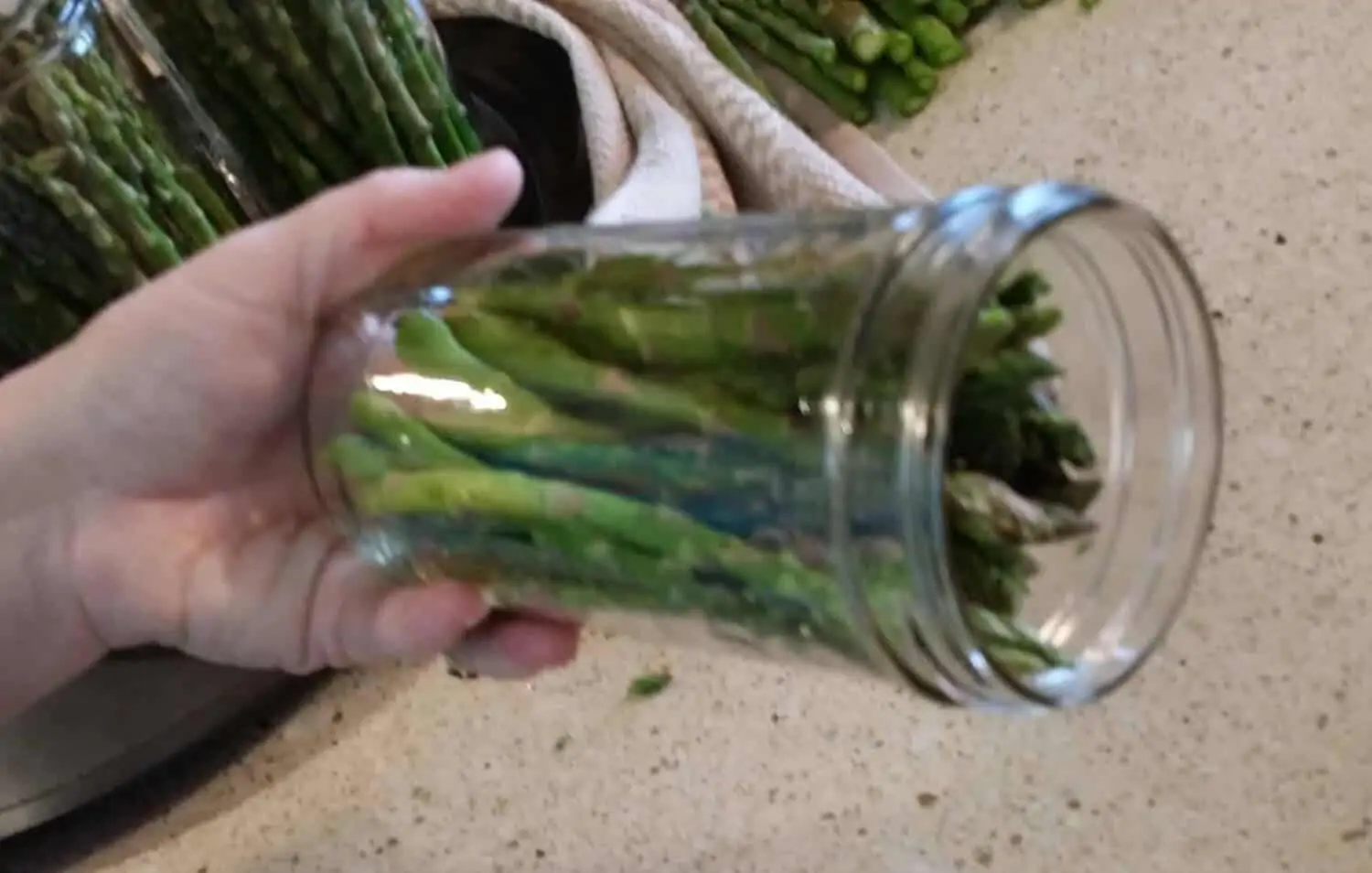
it’s easier to pack it in the jar when it’s sideways
Now fill the jar with boiling water, again leaving 1 inch of headspace. Add salt if desired, using ½ tsp for pints and 1 ½ pints, and 1 tsp for quarts.
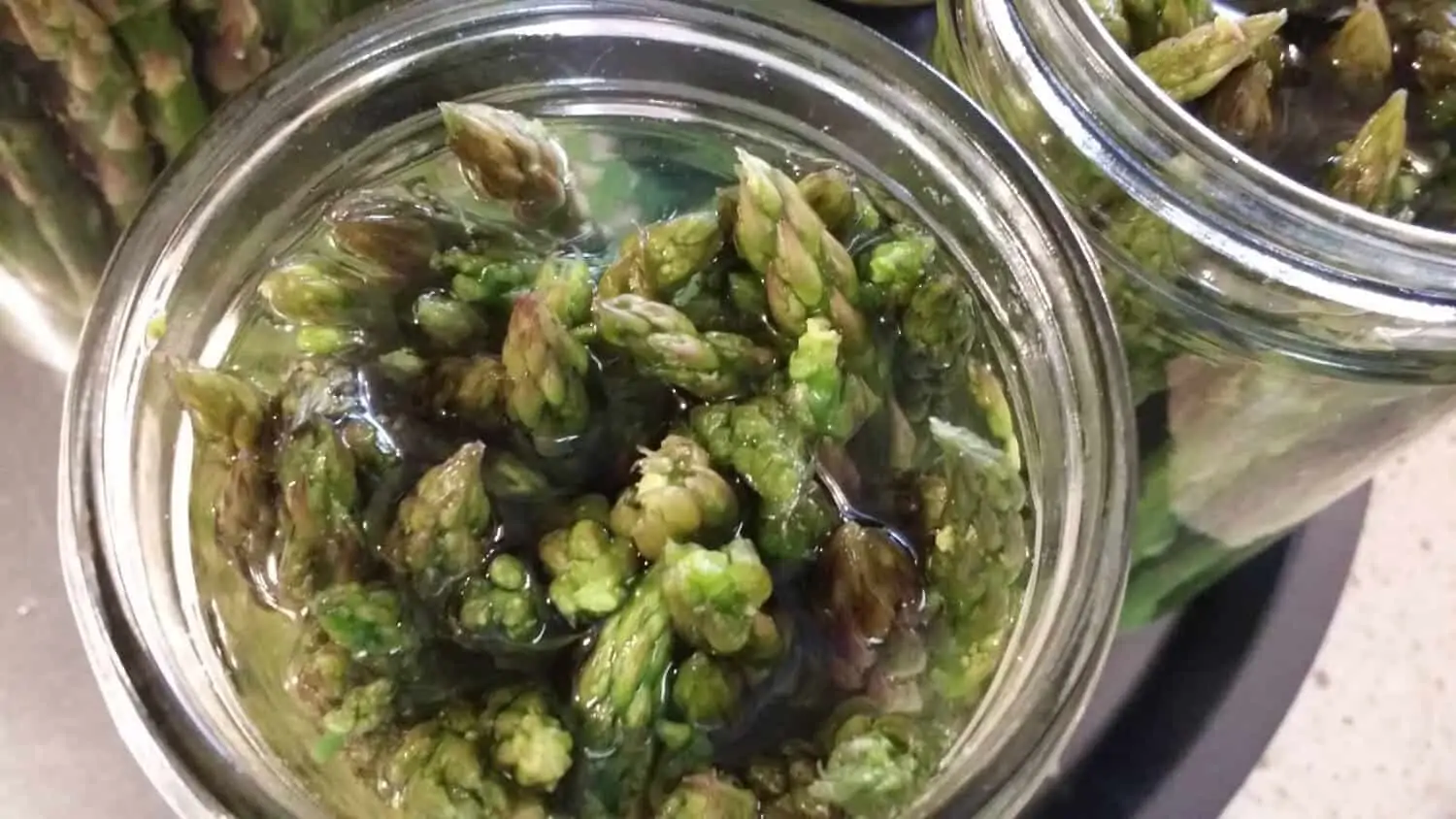
fill with boiling water
Wipe the rim with a clean, dry cloth. Now seat the lid and put on the ring, tightening just until finger tight.
Fill and close the remaining jars. Place the jars in the canner, adding the amount of hot water appropriate for your canner.
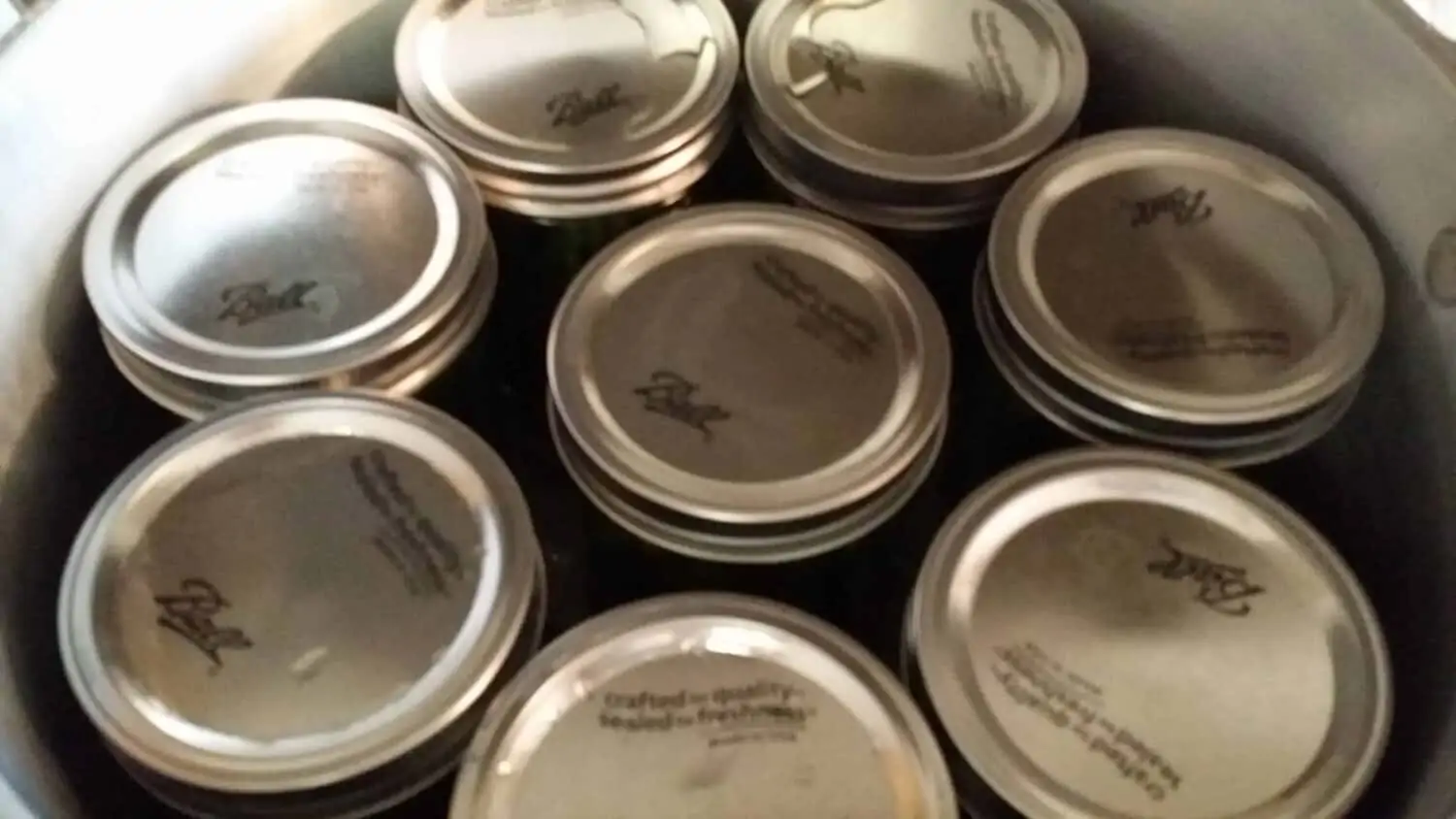
in the canner they go!
Secure the canner lid, turn on the heat, and vent for the amount of time specified for your canner.
Place the weight on the vent and bring up to pressure.
If you are using a dial gauge canner, process at 11 pounds pressure for 30 minutes for pints; 40 minutes for 1 ½ pints and quarts.
If you are using a weighted gauge canner, use the 10 pound weight and process for the same length of time.
Don’t forget to adjust for your altitude if necessary.
After processing allow the canner to cool down on it’s own.
Remove the jars and put them on towels in a draft free location to cool.
After a minimum of 12 hours, check the seals, make a cool label with the contents and the date, and put them in your pantry.
Now stand back and admire your handiwork!

all sealed and ready to go on the shelf!
Blessings!
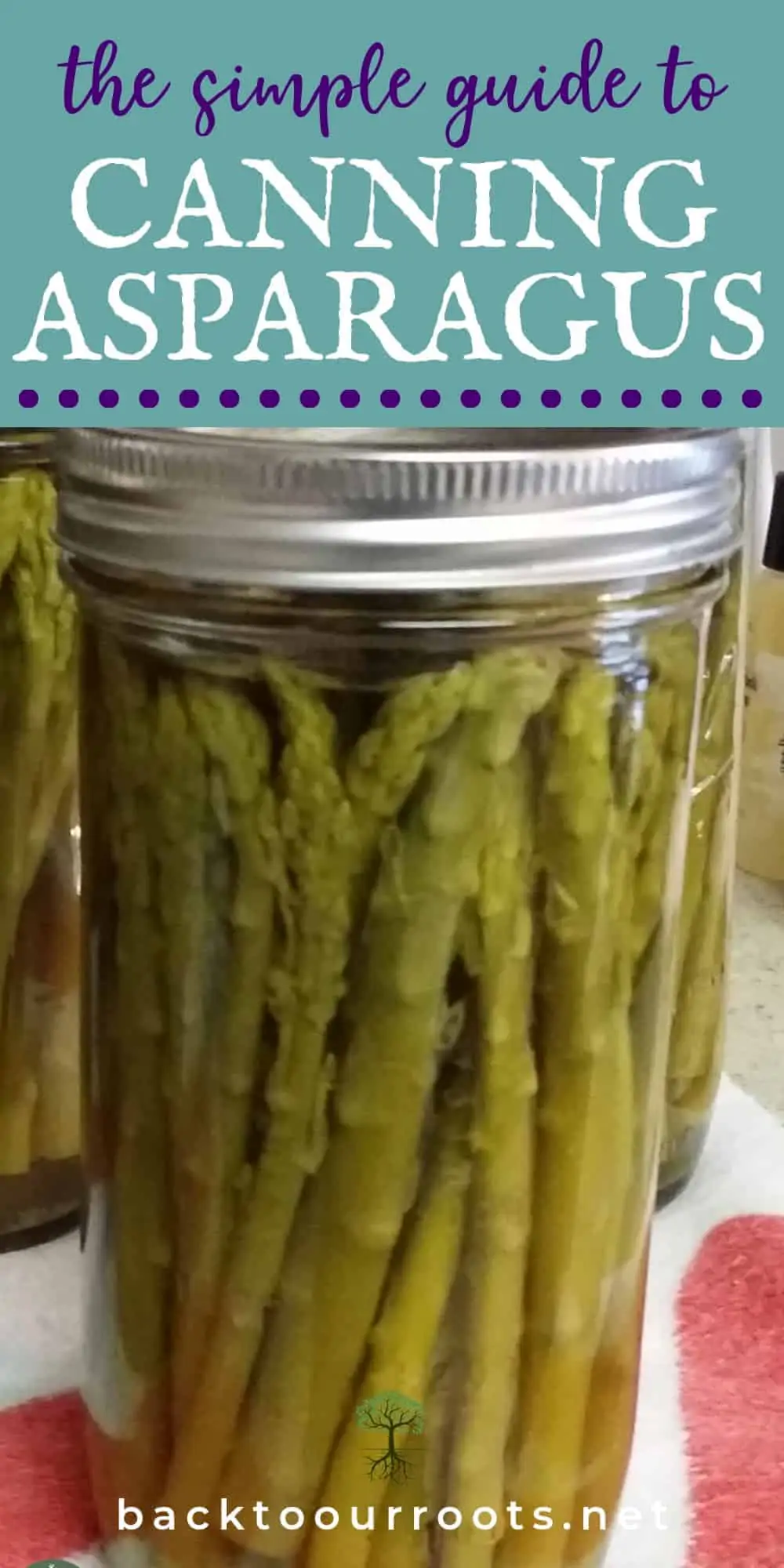
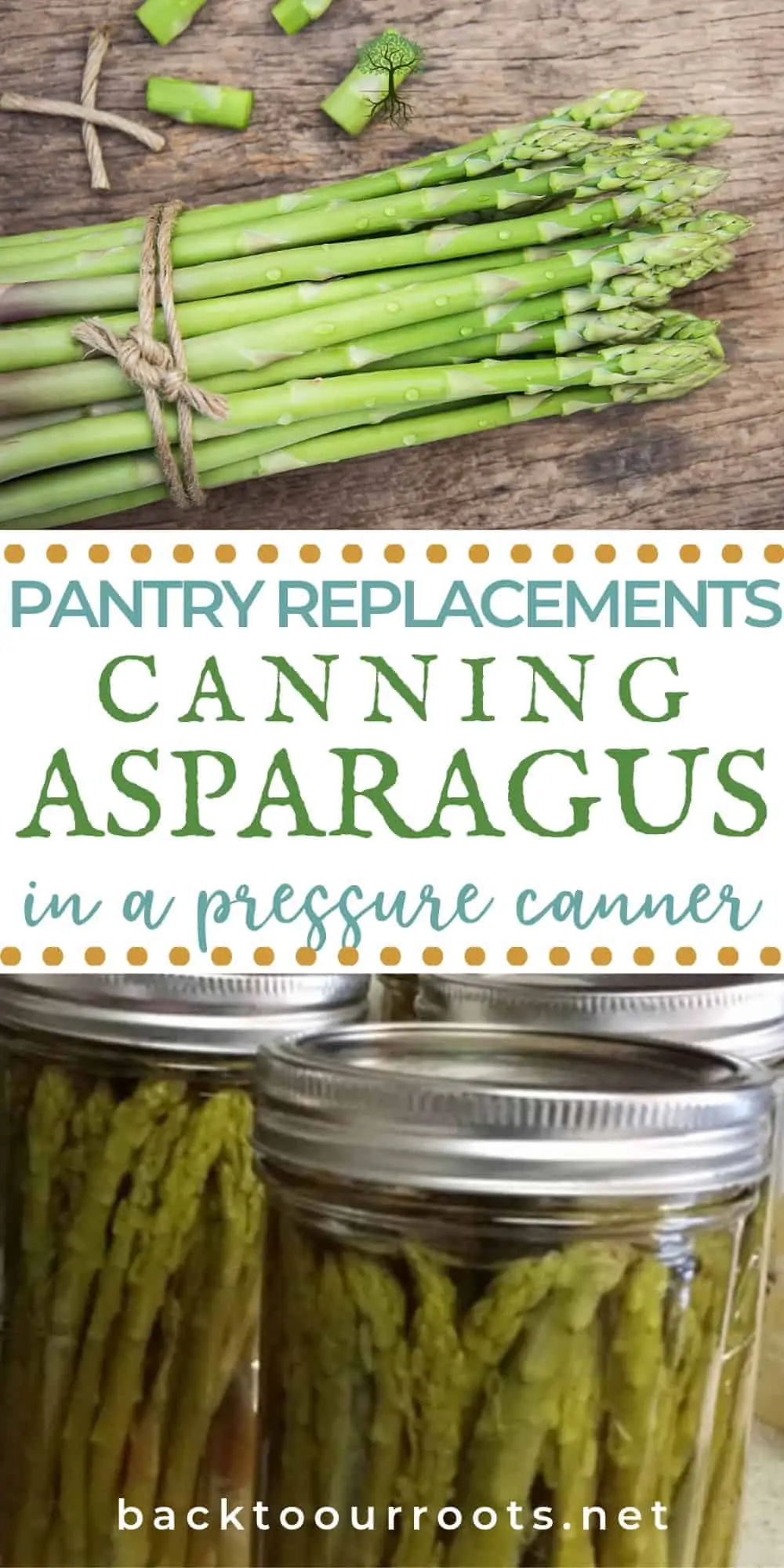




Shanon says
Are these “mushy” like all store-bought canned asparagus? Or does the raw pack method help with this?
Cery says
Sharon, unfortunately, it does make them mushy. I don’t think it’s as bad as the stuff you can buy at the store, but it’s possible that I’m biased. 🙂
Christina says
How long will they stay good after canned and shelved?
Cery says
Hi Christina! Home canned goods that are properly processed and stored in a dark, dry, cool environment will last for several years as long as the seal is intact. That being said, the quality of the foods begins to deteriorate after about a year(ish), depending on the items canned. With asparagus, they will continue to get softer as they are stored. I would recommend that they been eaten within a year for the best quality. Blessings!
Dana says
I make dilly asparagus every spring and summer. Delicious! It’s a dill pickled asparagus spear. But mine don’t go to mush. I process the same as you only using the usual, salt, garlic, dill. We can it the same, I process mine in the hot bath for only 10 minutes and then get them out of there. I have all of the many canning tools to move the hot stuff around. I’m going to try yours to just plain to have for the holidays. I don’t know why it never occurred to me. Although I seem to be able to get it in Delaware year around. I think I just like being in the kitchen and how beautiful the jars are when they are done.
Gerri Hudson says
Do you add water to your jars..
Jerry says
The first time I had asparagus was when I was in the Army, I’m not really a picky eater and am open to trying just about any food as long as it looks interesting, smells good and if it tastes good to me, with only a few things I’ve tried in my 64 years that I don’t like asparagus was one at that point, it tasted nasty and smelt bad, here to find out they cooked it to death and it sat for a long time a big no-no for asparagus, for years I wouldn’t even think of eating asparagus until a friend and I were camping and came across some wild asparagus, he talked me into trying it again but first raw, to my surprise there was a nutty beautiful flavor I had to have more of, we had our dinner that night in the woods made up of wild foraged edibles and I couldn’t get enough even after it was cooked, my friend being a professional chief at the time explained that over cooking turns asparagus into something terrible and I agree that is why I only eat it fresh and why I think I will not try to can it and why I only buy fresh, my wife and I do a lot of canning but I cannot convince her to try asparagus since she had a similar experience and is a very picky eater.
Cery says
I have never seen it growing wild! That’s pretty cool. My favorite way to eat it is actually grilled, but still crisp. 🙂 But I totally understand not liking it canned. Thanks for your comment!
Sarah Taylor says
How do you cook it after it’s canned?
Cery says
Sarah, I put it in a small saucepan with the liquid from the jar and just heat it up. It’s already been cooked through the canning process, so heating is all that’s necessary. 🙂 Thanks for stopping by!
Anne says
I read that you should take off the bands of the canning jar and just leave the tops where sealed. Is that correct information?
Cery says
Hi Anne! This is a hotly debated topic in canning circles. This is what the National Center for Home Food Preservation says, “It is recommended that jars be stored without ring bands to keep them dry as well as to allow for easier detection of any broken vacuum seals. However, if you choose to re-apply the ring bands, make sure all surfaces are clean and thoroughly dry first.”
I personally store mine with the rings on. I usually can around 1500 jars of food a year and in my current home I absolutely don’t have anywhere to store all those rings! I do make sure that the rings are loose on the jars. Tight enough to not come off when I pick up a jar, but not tight enough to be a problem if the seal gets broken. Since I have to store a lot of my jars back in the boxes and stacked on each other, I feel like the rings are actually protecting my seals. However, if I were storing the jars somewhere damp, the rings would probably rust which makes it difficult to remove from the jars. And if that were the case, I would figure out somewhere to store the rings separately.
So, which ever way you choose to store the jars is ok and totally up to you. 🙂
Joyce says
I just pressure canned my first asparagus. When I took the jars out, I found a lot of the water in the jars had evaporated! The tops of the asparagus aren’t covered in any water! What did I do work. They were pint jars.
Cery says
Hi Joyce! Yay! I’m so glad you gave asparagus a try! 🙂
Having less water in the jars is not uncommon and it’s not a problem. Everything inside the jar is sterile after processing, so it’s perfectly safe. There might be a slight discoloration after a while where the spears poke out of the water, but if you keep it somewhere dark that probably won’t happen.
The water loss can be caused by a few different things, so here are my thoughts.
1. If you put a little more water than the recipe says, the water can boil out during processing. Because the level is higher, it’s closer to the lid and can escape.
2. If there are air bubbles in the jar, the bubbles will pop during processing and your water level will be lower.
and, 3. If the jars aren’t lifted straight up out of the canner the water can leak out. The lids often don’t seal while the jars are still in the canner, and lifting at an angle can cause some water loss.
So those are things you can check next time you can. But as I said, the contents are perfectly safe to eat. Blessings!
Thomas W McCort says
I love pickled asparagus. My recipe calls for blanching it for 4 minutes, then packing in jars and covering it with a vinegar / water / salt / garlic / spice brine. It then goes in the fridge for 3 days before it’s ready to eat — CRISP & YUMMY. I was hoping to find a recipe here to pressure can it for long-term storage, but from what I’ve read, that would probably make it mushy. We keep it refrigerated up to several weeks (if it lasts that long), lol.
Cery says
Hello Thomas! You are right, pressure canning it will probably make it mushy. However, with the vinegar in it you might be able to waterbath can it. You can always process one jar in the pressure canner and see what it’s like, though! Sounds like a great pickle recipe!
Hiedi Vogele says
Pressure canning some now. It is supposed to be helpful to bring blood pressure down but I don’t want nasty cans of teh stuff. Glass jars are best. Making pints but might try 1 1/2 pints next time.
Betty McCorkle says
Question. When canning asparagus in a pressure cooker, my asparagus spears twisted and pushed to the top. They have straightened out a little, but now there are several tops not quite covered with liquid. What causes the twisting? Is it safe to have a few tops slightly out of the liquid? Thank you.
Cery says
Hi Betty! The twisting is perfectly normal. If you pack them a little tighter that will keep some of that from happening. The tops out of the liquid is not a problem. The tips might darken a little bit from being exposed to the air left in the jar, but it’s perfectly safe to eat. Blessings!
Sven Johansen says
Hello, I am no novice to canning either hot bath or pressure canning. This is the first time I have attempted pressure canning of Asparagus. I purchased 60 lbs. of fresh spears. I followed your canning instructions exactly.
The only difference in my canning endeavor was after washing and trimming the ends was to cut the spears into 1-1/4 inch pieces and then pack tightly into quart jars (cold pack). I gave each jar a measure of sea salt and filled each jar with boiling water up to the 1 inch headspace. Any air was removed so it was all liquid and veggies no gaps. After tightening the lids the jars went into my pressure canner ( 19 ) quarts at a time. I live in Wisconsin so altitude was considered and adjusted for processing time. I processed the asparagus for 40 minutes @ 10 Lbs. pressure (dial gauge) and when the time was up I removed the quart jars from the canner.
I have never had this happen before!! Some of the quart jars were less than 2/3rds full of liquid after processing. Before you ask, All of the lids were checked for tightness before being placed in the canner. Does raw asparagus absorb that much liquid?? Incidentally I processed one quart as spears and it turned out perfectly with a normal amount of shrinkage. I did the pieces to save time.
Any suggestions what happened to the liquid?
Cery says
Hi Sven! Depending on how long the asparagus has been cut and how it was stored, it can sometimes absorb a ton of water. I noticed that myself this past year. What I’ve started doing with purchased spears is to cut the bottoms and set them upright in glasses of water overnight in the fridge. That way, they can suck up the water before canning. Perhaps the difference in the liquid from the whole spears and the cut was that the cut pieces had more ends to absorb the water? That is really interesting, though.
Peggy Rabe says
I’ve had great success picking asparagus, using just a canner and 10 min cooking time. I don’t have a pressure canner. Do you think I could can plain asparagus using a canner, rather than a pressure cooker?
Cery says
Hi Peggy! Unfortunately, asparagus cannot be waterbath canned unless it is pickled. The pickling liquid keeps the acidity level in the safety zone for waterbathing. Low acid foods must be pressure canned for safety. Blessings!
Sylvia Streza says
My canning book did not tell me to add boiling water to my pieces of raw pack asparagus. I processed them the way they said. Are they still going to be ok. All the jars popped after I took them out of the water bath. This is the 1st time I ever raw packed anything. Thank you for any help.
Cery says
Hi Sylvia!
Asparagus has to be processed in a pressure canner unless it’s an approved pickling recipe. I might be misunderstanding, but if by “water bath” you mean a waterbath canner, then they are definitely not safe to eat.
And, unfortunately, even if they were processed in a pressure canner, not having water for even heat distribution probably means that they aren’t safe to eat.
So I would definitely err on the side of caution and throw them out. So sorry.
Cery